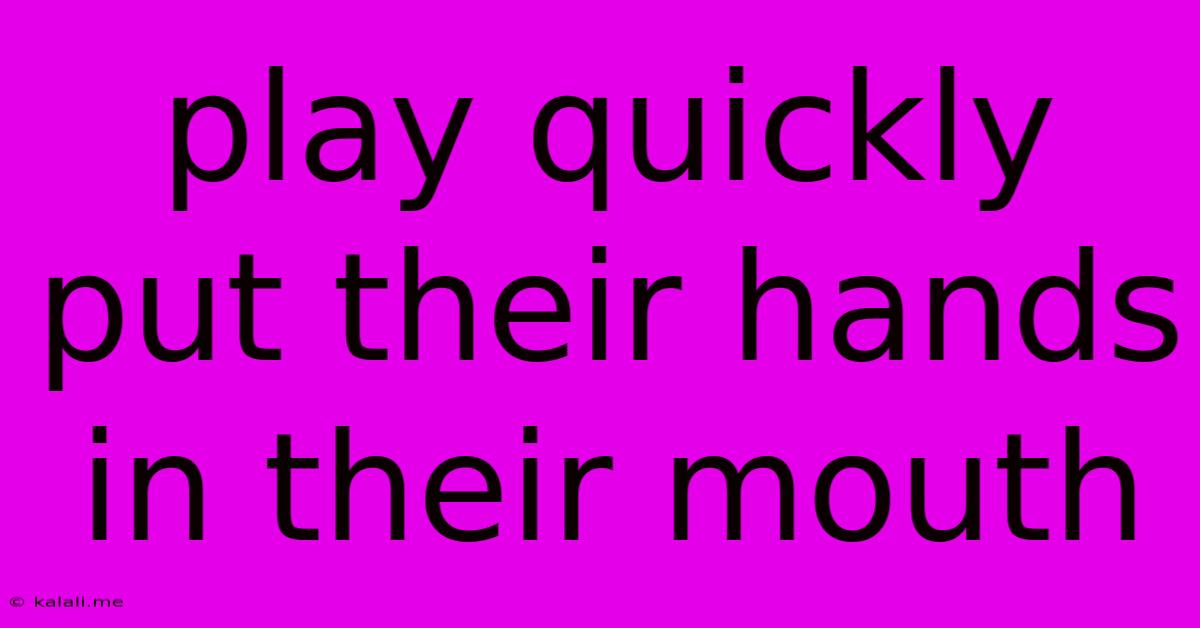Play Quickly Put Their Hands In Their Mouth
Kalali
Jun 04, 2025 · 3 min read

Table of Contents
Why Do Babies Put Their Hands in Their Mouths? A Developmental Look
Why do babies constantly seem to have their hands in their mouths? It's a common sight that often leaves parents wondering about the reasons behind this seemingly endless habit. This article explores the developmental milestones and reasons behind this behavior, offering insight and reassurance for parents. Understanding this phase can help alleviate concerns and provide a deeper appreciation for your baby's growth and exploration of the world.
The Developmental Stages of Oral Exploration
From the moment they're born, babies rely heavily on their sense of touch. Their mouths are incredibly sensitive, acting as a primary tool for exploration and learning. This oral exploration is a crucial part of their development, serving several important functions:
- Sensory Stimulation: A baby's mouth is packed with nerve endings. Putting their hands in their mouth provides intense sensory stimulation, helping them learn about texture, temperature, and shape. This sensory input is vital for brain development.
- Self-Soothing: Sucking is a natural reflex and a powerful self-soothing mechanism. When babies feel anxious, tired, or uncomfortable, placing their hands in their mouth provides a comforting and familiar sensation. This is especially true during teething.
- Pain Relief: The pressure and sucking action can provide a degree of relief during teething, when their gums are sore and inflamed. This instinctual behavior is a natural way for them to manage discomfort.
- Cognitive Development: The act of exploring objects with their mouth helps babies learn about cause and effect. They learn about the world through taste, texture, and the sensations provided by the objects they explore.
- Developing Fine Motor Skills: This seemingly simple action contributes significantly to the development of fine motor skills. The coordination required to bring their hands to their mouth, grasp, and manipulate objects strengthens their hand-eye coordination and dexterity.
When Should You Be Concerned?
While putting hands in the mouth is a normal developmental stage, there are times when it might warrant attention:
- Excessive Hand-to-Mouth Behavior: While some hand-to-mouth activity is normal, excessive or compulsive behavior could indicate underlying anxiety or developmental delays.
- Persistent Hand-to-Mouth Behavior Beyond the Expected Age: Most babies significantly reduce this behavior by around 18 months, but the timeline varies. If it persists beyond the typical age range, consult a pediatrician.
- Other Associated Symptoms: If hand-to-mouth behavior is accompanied by other symptoms like difficulty sleeping, irritability, or changes in eating habits, a medical evaluation may be necessary.
Supporting Your Baby's Development
Understanding the reasons behind this behavior helps parents respond appropriately. Offering comfort, providing safe toys to explore, and ensuring a secure and loving environment can promote healthy development. Remember, this phase is temporary, and as your baby grows and develops their other senses, the frequency of hand-to-mouth behavior will naturally decrease.
Conclusion
Babies putting their hands in their mouths is a normal and crucial part of their development. It's a sign of healthy exploration, self-soothing, and sensory learning. While observing for any concerning signs is important, generally this behavior is a natural step towards growth and a fascinating insight into the wonders of early childhood development. Enjoy this phase, as it’s a fleeting glimpse into your baby's unique journey of discovery.
Latest Posts
Latest Posts
-
2 0 Copper Wire For 200 Amp Service
Jun 06, 2025
-
2011 Honda Civic Air Conditioning Not Working
Jun 06, 2025
-
How To Add Refrigerant To Air Conditioner
Jun 06, 2025
-
Sql Parse Script To Get Table Name And Alias
Jun 06, 2025
-
Is It A Code Violation Not To Have Basement Windows
Jun 06, 2025
Related Post
Thank you for visiting our website which covers about Play Quickly Put Their Hands In Their Mouth . We hope the information provided has been useful to you. Feel free to contact us if you have any questions or need further assistance. See you next time and don't miss to bookmark.